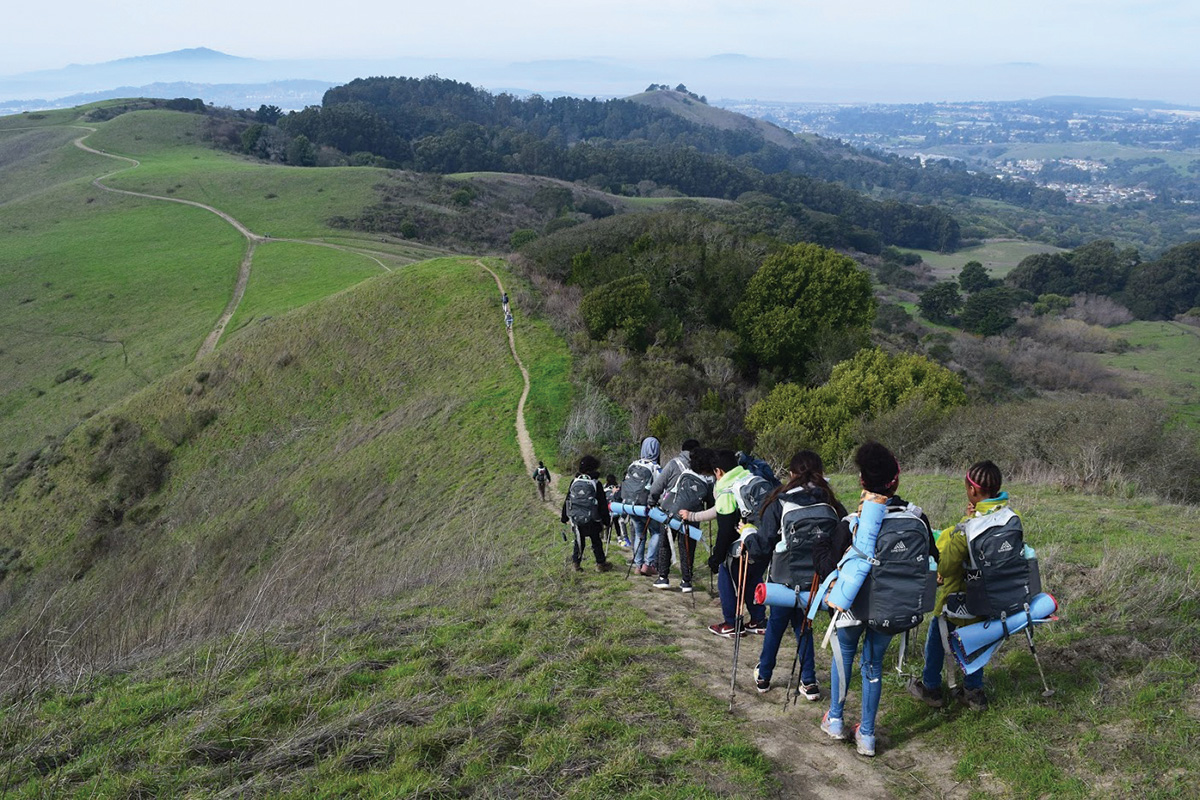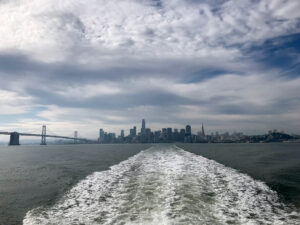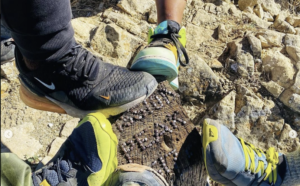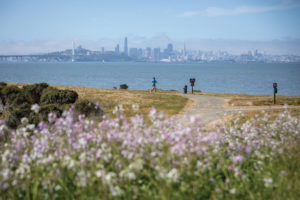On a crisp, bright Saturday morning in December, Andrew Fonseca, age 12, has joined a group of middle schoolers at the front gates of the Regional Parks Botanic Garden, in Tilden Park above Berkeley. His first reaction to the garden: “I can’t believe how big it is.”
The preadolescent energy is palpable, even as the kids try to conceal it, playing it cool while chatting with their friends. They adjust their backpacks. They shift weight from one foot to the other and study the garden in front of them.
James Wilson, the Park District supervising naturalist leading the day’s outing, asks, “What would everyone like to see first?”
Andrew and the rest of the middle schoolers are all part of an innovative program, Adventure Crew. A collaboration among Richmond-based YES Nature to Neighborhoods, the East Bay Regional Park District, and San Francisco State University, Adventure Crew works to solve a stubborn, contradictory problem. When it comes to public parks and open space, the San Francisco Bay Area is uniquely blessed. But for many Bay Area kids, these beautiful natural places seem so inaccessible they might as well be on another continent. Which is why Andrew and his friends are taking this hike on Saturday morning.

The East Bay Regional Park District is big. Stretching across Alameda and Contra Costa counties, its 73 parks encompass 125,000 acres. In fact, some 99 percent of East Bay residents live within five miles of a Regional Park. Eric Aaholm, executive director of YES, says that when YES first began its partnership with the EBRPD, he was impressed by how the parks connect to one another to form a near-unbroken chain of green. “It’s one of the jewels that we have with our parks, and the perspective that it opens up for our young people is extraordinary.”
And yet many East Bay kids have grown up with little access to these parks or to any outdoor experiences. The barriers are invisible but real. Time and money constraints, transportation limitations, family or cultural history, and simply not feeling welcome all play a role.
Removing these obstacles isn’t easy. “This is a big-time equity issue,” says Aaholm. “We can’t just say ‘outdoor access for all’ and expect people to come because we are making the parks inclusive. It goes beyond putting up signs in languages other than English. It’s rethinking how people use park space.”
Enter Adventure Crew. The newly designed EBRPD program found a ready partner in YES and in San Francisco State University. Each Adventure Crew course lasts 10 months and includes between 15 and 20 students. Trained EBRPD naturalists are chosen for their expertise in outdoor education and, equally important, for their ability to connect—to build trust and openness—with youth from diverse backgrounds. Over each session, they lead crew members in monthly activities that include two daylong excursions—like the trip to the Botanic Garden—and a family night, when participants, parents and guardians, and staff enjoy a meal together and share updates about Adventure Crew activities. The program culminates in two overnight backpacking expeditions in parks like Sunol Wilderness Regional Preserve and Point Reyes National Seashore.
David Zuckermann, Park District regional interpretive and recreation services manager, was one of the people who conceived the program. He hopes Adventure Crew will introduce new possibilities for its participants. “When you have communities that haven’t had access (to nature), you have kids who are coming in from ground zero. And then you’re taking them out, and it’s like you’re opening this window that had been completely closed.”

A Saturday exploration of the Botanic Garden isn’t a backpacking trip. But James Wilson encourages the kids to pay attention to everything around them, because adventure could lie around the next corner.
For Wilson, nature isn’t something you have to struggle five miles up a mountain to discover. It can be glimpsed when you turn over a rock in your backyard or take a look in the gutter after a rain to see what kind of creature got washed out. “The grandeur of being in a wilderness park and experiencing these things sets the stage,” he says. “But once you get turned-on and tuned-in to nature happenings, they are all around us.”
Middle-school-age kids like Andrew are also especially receptive to outdoor education, Wilson believes. “They are still trying to figure themselves out, figure out what it means to be a teenager. They’re too old to do any of the little kid stuff but still inherently interested in nature exploration.”
On this Saturday outing, Wilson and Park District recreation leader Stewart Reid guide the Crew through the Botanic Garden’s 10 acres, where plantings showcase the enormous variety of California ecosystems, from lush coastal rainforests to deserts. The plethora of plant labels, locations, and stories keeps conversation going as the students amble along the garden’s paths. One student carefully analyzes the map Wilson has handed out. She’s hoping to see rare and unusual plants—the garden grows more than 100 specimens. Other kids pepper Reid and Wilson with questions. “Which plants are poisonous?” “Which plants can we eat?” “Where can I see ocean plants?” What if a raccoon comes out during the day?”
Reid thinks exposure to nature can be life-changing. At the program’s start, he says, many kids are scared of the outdoors because they have never experienced it. But once they learn new skills like fishing, setting up a tent, and canoeing, they develop a sense of courage and become stronger individuals in all parts of their lives. “Everything you ever wanted,” he says, “is on the other side of fear.”
Research is another Adventure Crew goal. The Park District was determined to measure the effectiveness of the program not just with anecdotes but with data. It turned to Aiko Yoshino, an assistant professor at San Francisco State University, to aid in structuring the Adventure Crew program, studying its effectiveness and measuring outcomes. Yoshino is an expert on the health impacts of kids’ exposure to nature. Growing up in Yokohama, Japan, which she describes as a concrete jungle, she had a thirst for the outdoors, which ultimately led her to focus her research on connecting urban youth with nature.
To study Adventure Crew outcomes, Yoshino interviewed the middle schoolers who had participated in the program. She asked them to describe their views of nature prior to joining Adventure Crew. Many students, she says, believed nature was scary, describing it as a “not fun” place, a “dirty and boring” place, “full of trash” and “guns.” Some students did not view nature as a place they should go by themselves.
At the Adventure Crew program’s end, Yoshino found the kids’ views had significantly changed. Now the students appreciated nature in more intimate and relational terms. They saw nature as a place to enjoy—where they could climb rocks, swim, fly kites. And it was a place of discoveries, big (beaches, mountains) and small (rocks, pine cones). They brought up accomplishments they felt proud of: finishing a long, steep hike; identifying plants and animals; learning how to set up a tent.

It isn’t only the kids whose world has expanded thanks to Adventure Crew. The program’s staff members feel passionate about it, too. For the Park District’s David Zuckermann, the work is “not a job. It’s a calling.”
YES program director Blanca Hernandez says working with Adventure Crew let her share a love for the outdoors that began with her childhood in Mexico. “I grew up in the desert with a lot of animals and the ability to go outside and explore and not be supervised by my parents,” she recalls.
Hernandez’s love of nature stayed with her when she moved to the Bay Area and began working in Richmond schools. But she also came to see that the outdoors she depended on to recharge her internal batteries wasn’t readily available to the neighborhood’s low-income and immigrant families. Hernandez liked to go camping; on one trip, she remembers, she found herself dreaming “how it would be so cool” for Richmond families to experience the outdoors that she loved.
“The whole notion of who gets to access the outdoors is at the forefront of the work that we do here,” Hernandez says. “It’s very important to provide the context of history for people. To understand that we were all connected to nature at one point and how we came to be somewhat disconnected from it.”
At lunchtime the kids gather on the lawn near the pond and pass around snacks. Several kids peer into the water in search of newts. After finding one they take turns photographing it. At the end of the meal one student is selected to be the “Eagle Eye”—the person tasked with scouring the area for any bits of leftover trash.
After lunch, Andrew and the other Adventure Crew members continue their exploration of the garden and head into the sea bluffs section. They’ve been on their feet a few hours, but for Andrew that is no problem. When he started with Adventure Crew, he was apprehensive about long hikes. Now, he says, “Hiking is not that hard.”
Often, the benefits of the Adventure Crew program extend to the kids’ families. That includes Andrew’s two siblings and their mother, Yesenia Perez. Perez discovered YES when looking for Saturday activities for her children to enjoy while she was at work. Andrew’s older sister led the way by participating in several YES programs. His younger brother says he can’t wait until he is old enough to join Adventure Crew.
Her whole family now takes refuge in nature, Perez says. They recently took a trip to Wildcat Canyon Regional Park, Andrew and his sister acting as guides as they followed Wildcat Creek off-trail. The three siblings made rock paint by rubbing two stones together to form a powder and daubed it on everyone’s faces. Andrew showed off his berry and insect ID skills. Also his navigation ability: when the family briefly became lost, he stayed calm and guided everyone back onto the trail.
Now, later in the Saturday afternoon, as the students meander along the garden pathway, they come to a bridge over a creek. Walking out onto it, they pause and lean over the railing to gaze at the water rushing beneath them. A few of the students grow contemplative.
“A lot of our students are not used to the solitude and quiet time with their thoughts,” notes YES youth leaders coordinator Peter Walker-Flom. “That experience can be really intense when they are processing a lot.” These periods of reflection can be powerful, a chance for students to share their thoughts with their friends and mentors. “We’ve learned to be prepared for anything that comes up out there,” Walker-Flom says. “It’s always a mix of incredible, joyful experiences and creating space for youth to really think long and hard about their lives.”
At the close of the day, Andrew and the rest of the Adventure Crew gather in a circle on the Botanic Garden lawn. They end with a Crew tradition: each student shares a symbolic rose, a thorn, and a bud. The rose stands for something they liked about the day, the thorn for what could have been better, and the bud for something to look forward to. The activity gives everyone a chance to debrief. When it is Andrew’s turn, he says his rose is today’s trip itself—“it was cool.” The bud is looking forward to more Adventure Crew Trips in the New Year. Then he and the other kids climb onto the bus that will take them home.





